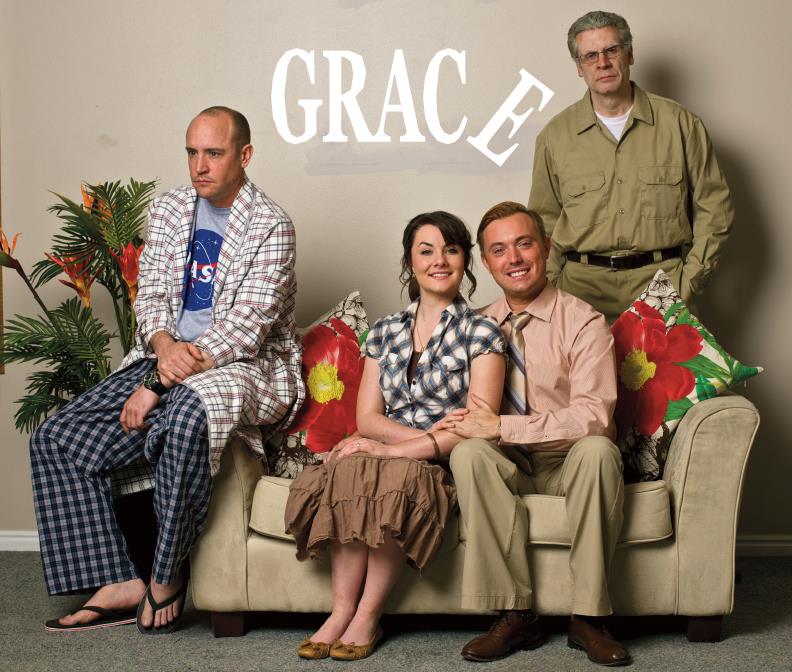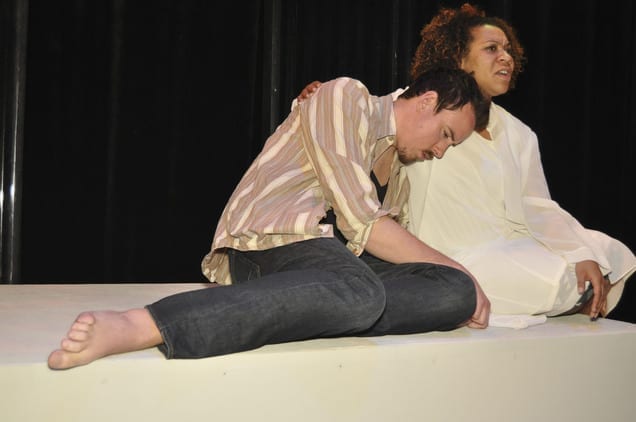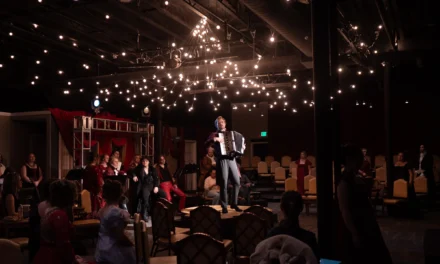SALT LAKE CITY – Grace is the story of two parallel worlds that each happen to take the form of a small Florida rental condo. The first condo is the home of Steve and Sara, a married couple who have just moved from St. Paul, Minnesota, to Florida to start a chain of Gospel-themed hotels. The second condo belongs to Sam, a NASA engineer who recently lost both his fiancée and half his face in a car accident.
The condos were represented by a stand-alone doorway, some basic living room furniture on one side of the stage, a dining table and chairs on the right. The same set (designed by director JC Carter) was used for both condos, and often the action in the two households happened at the same time, right on top of each other. Seeing the events of the two condos transpire in parallel was my favorite part of the play, as it emphasized the way the lives of Steve, Sara, and Sam were entwined.
Having watched my share of Doctor Who, I’m very familiar with the fact that crossing between parallel worlds always has unforeseeable consequences for each. And such is the case in “Grace.” When Steve and Sara move to Florida, their life has a clear trajectory: Steve (played by Johnny Hebda) will start his Gospel-themed hotel and evangelize the world as soon as money is wired to him from a non-fraudulent donor in Switzerland while Sara is pressuring Steve to have a baby with her. But Steve and Sara’s lives are quickly thrown off course as circumstances change and Sam gets involved.
Johnny Hebda played Steve as the formulaic evangelical Christian who sees faith as a panacea to the gambit of problems from the spiritual to the financial. He is known to say things like, “In real estate, what matters is belief. Is the money here? Is the money there? I don’t care!” Craig Wright’s script develops Steve as such a cartoonishly stereotypical Christian—in his pushy proselytizing and hypocritical application of scripture—that he was hard to like or even sympathize with. Still, Hebda played the role with fervency. His strongest scenes were those where Steve’s hypocrisy became comic.
Steve’s wife Sara (Emilie Eileen Starr) was instantly likeable, probably because it was hard not to feel bad for anyone married to Steve. Sara’s brand of Evangelical Christianity allowed room for human sympathy, which lent flexibility to her views. The script doesn’t develop Sara’s motivations much beyond her desire for a baby, but Starr played the character with such compassion that it was easy to feel for Sara as she experienced a world broader than anything she’d known in St. Paul.
For me, JayC Stoddard’s character, Sam, made the most sense of all. He was a reasonable guy who’d just lost everything important to him, and all he wanted was to spend some time being really sad about it. As a NASA engineer, he made statements about space and time that Wright clearly meant to be applied metaphorically to the action on stage. But, even with some of the wooden writing for his character, Stoddard was absolutely believable. While Sam wore a constant cloak of despair, he was also able to inhabit other emotions, so that – of all the characters – Stoddard’s felt the most human.
An exterminator named Karl shows up only in the opening and closing scenes of the play. Played by Jeffrey Owen, Karl just wants to do his job without being proselytized to. But when Steve manically tries to evangelize him, Karl is pressed to recount the experiences as a child in Nazi Germany that led him to adopt atheism. Karl’s bookend appearances provided contrast for the action seen between them, and their context within the greater action still has me thinking.

Left to right: JayC Stoddard, Emilie Eileen Starr, Johnny Hebda, and Jeffrey Owen. Photo by Alex Weisman/IceWolf Photography.
The costumes (designed by Nancy Susan Cannon) were fairly simple. Steve tended to wear khakis and button-up shirts. Sara and Sam dressed in the casual attire of people who don’t go out much. Throughout most of the play, Sam wore a mask to cover his facial scars. Removing the mask could have easily turned comic or disappointing, but the scars created with Kelly Donahue’s makeup were just right.
The breaks between scenes were longer than seemed necessary for minor costume changes. The music played between scenes (by Mikal Troy Klee) led me to wonder whether the long breaks were intentional. Still, almost every scene built up some intensity that was then lost during the breaks and had to be rebuilt in the next scene. For me, rather than allowing me to catch my breath between each scene, the stop-and-go pace made me feel a bit like I was about to have a panic attack.
Grace was unlike anything I’ve yet seen on stage. Wright’s script ambitiously tackles weighty abstractions like space and time and explores them within the context of four people’s transitioning faith. With so much on this play’s agenda, I’m still impressed at how much Wright and Utah Repertory Theater Company got right and have me thinking about the play days later.






